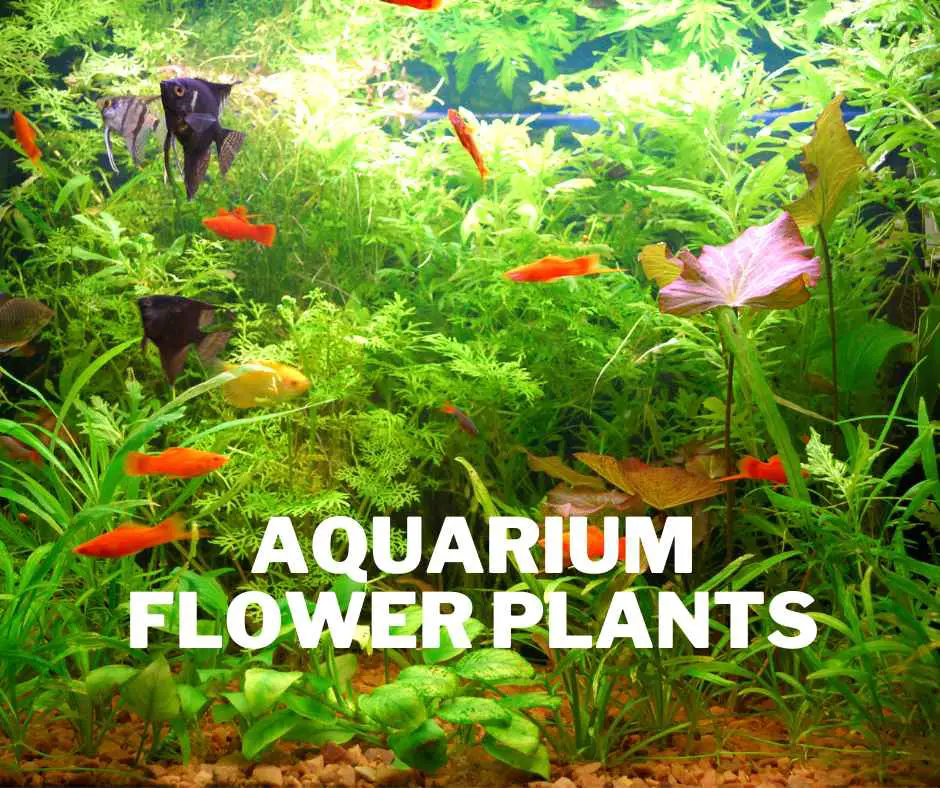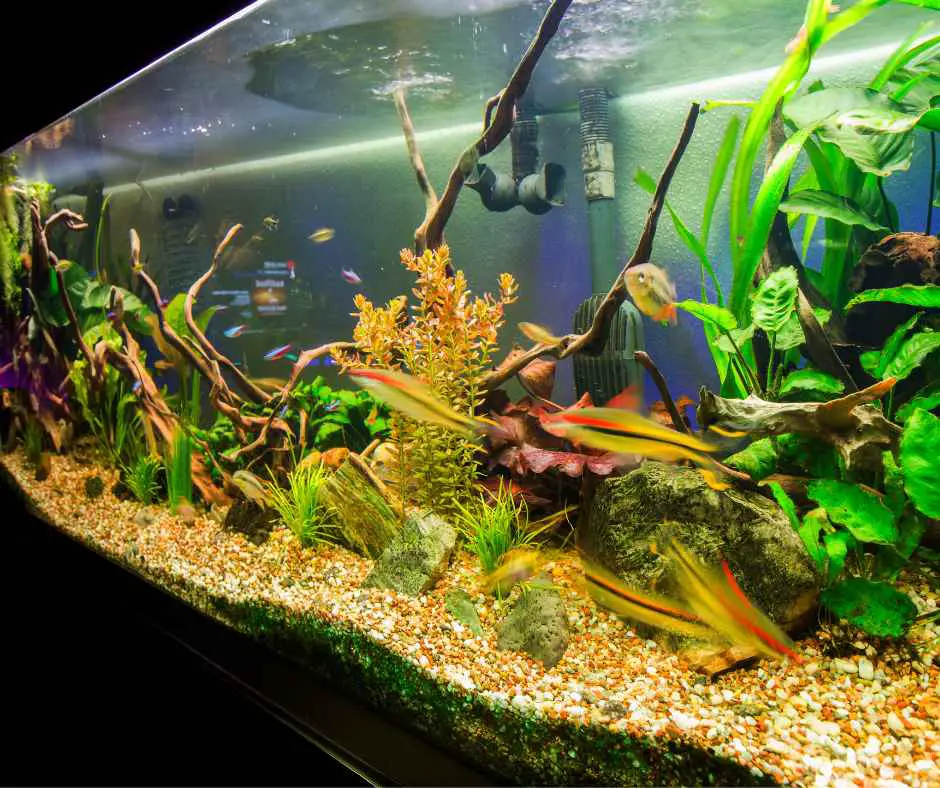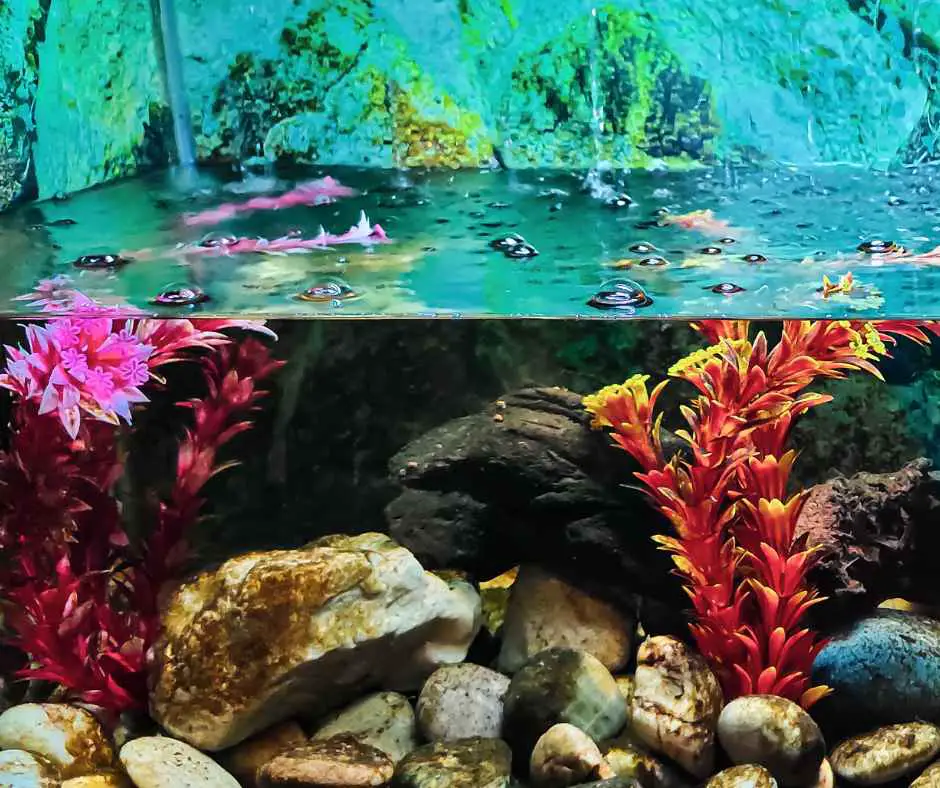When people run out of space, or when they want their passion for gardening to reflect everywhere even in indoor settings. They go for container gardening, or they go for the plantation of aquarium flower plants.

Aquarium flower plants, also known as aquatic flower plants can grow and survive in the aquatic environment. These are the plants that have adopted the aquatic environment. These are planted for many reasons. That’s why we are going to discuss aquarium flower plants.
Aquarium flower plant
Aquatic flower plants are plants that grow in water or a waterlogged environment. These plants can be divided into two main categories: submerged and emergent. Submerged aquatic plants grow entirely underwater and are typically used as oxygenators, which help to keep the water clear and healthy for fish and other aquatic life. Examples of submerged aquatic plants include hornwort, watermilfoil, and Cabomba.
Emergent aquatic plants, on the other hand, grow with their roots in water, but the majority of the plant emerges above the water’s surface. Examples of emergent aquatic plants include cattails, reeds, and water lilies. These plants provide a natural habitat for fish and other aquatic life, as well as help to keep the water clean and clear.
You can go for any of these plants. Important is that you get the right actions which are required by any of the plants to grow healthy and steadily.
Characteristics of Aquarium flowers
Aquarium flower plants have a variety of characteristics that make them well-suited for growing in an aquarium environment. People go for many reasons to plant these beauties. Here are some of the important characteristics:
Moderate light requirements
Many aquarium flower plants can thrive in low-light conditions, which makes them ideal for aquariums that are not located in direct sunlight. Some of these might require full, or moderate sunlight to grow well.
Adaptive to the aqua climate
Aquarium flower plants can adapt to a wide range of water conditions, such as pH levels, temperature, and hardness. That’s why these can survive easily.
Oxygenating properties of aquarium flower plants
Many aquarium flower plants can oxygenate the water, which helps to keep it clear and healthy for fish and other aquatic life. That’s why these plants are adopted. They have multiple benefits.
Nutrient absorption ability
Some aquarium flower plants can absorb excess nutrients from the water, which can help to reduce algae growth. Also, if there is fish or other aquatic life in the water, it will not get affected by the excess of nutrients.
Variety of sizes and shapes
Aquarium flower plants come in various sizes and shapes, from small, delicate, and leafy to large and tall, providing different options to decorate an aquarium. You can choose any of them.
Reproduction in aquarium flower plants
Some aquarium flower plants reproduce through runners or by producing offshoots, allowing them to spread and fill in the aquarium. This makes it easy for gardeners that they don’t have to worry about planting the plant every year.
Hardiness
Some species are hardy and can withstand a range of environmental conditions, making them suitable for beginners. Growing in water is itself a great hardiness.
Aesthetics
Many species of aquarium flower plants are colorful and add visual interest to the aquarium. With their varied size, shapes, and colors you can choose according to your choice of decoration. They will surely add value to the decoration.
Also, Read
How To Plant Silver Dollar Eucalyptus
Things to consider before planting aquarium flower plants

As these plants are different from other land plants, because they have to grow in aquatic settings, they need some of the steps taken into consideration. Some of the important are as follows:
Lighting Requirements of aquarium flower plants
Aquarium plants need bright, full-spectrum lighting to photosynthesize and grow. They should receive at least 6-8 hours of light per day. While some of the plants can survive in low light as well.
Substrate
A nutrient-rich substrate, such as plant-specific aquarium soil or a substrate rich in iron, is important for the growth of flower plants. This will ensure good growth of the plant, as well as it will give it a natural look.
Fertilization requirements of aquarium flower plants
Aquarium plants require nutrients to grow, so regular fertilization with a plant-specific fertilizer is necessary. You can add balanced fertilizers of iron, cobalt, manganese, etc.
Water Parameters of aquarium flower plants
Aquatic plants prefer a pH range of 6.0-7.5 and a water temperature of 72-82 degrees Fahrenheit. Make sure it is not so acidic or basic, and the temperature is also well maintained.
Co2 injection
It is not a must-have but CO2 injection can help the plant to grow faster and healthier. It depends upon your will whether you want gradual growth of the plant or fast growth.
Pruning
Regular pruning of dead or dying leaves is important to maintain the health and appearance of the plant. It will also help in ensuring the life of aquatic animals and fishes.
Aquarium flower plants
There are many aquarium plants available in the market. you can opt for any of these. Some of the most common are as follows:
Anubias
Anubias is a hardy, slow-growing plant that can be attached to rocks or wood in the aquarium. It requires clean water and it doesn’t require the substrate to grow well.
Java Fern
The most common plant in the aquarium setting is the java fern plant. These plants are also slow in growth. They have very unique leaf structures and can survive in a variety of settings. It can even survive in slightly acidic or basic settings as well.
Amazon Sword
Amazon sword is a fast-growing plant that can be planted in the substrate, it prefers moderate to high lighting and nutrient-rich water. It produces oxygen that can be used for aquatic life.
Hornwort
Hornwort is a fast-growing, free-floating plant that can be used as a natural filter in the aquarium. It is liked in both aquarium and open settings. It can absorb excess nutrients from the water.
Water Wisteria
Water wisteria is a fast-growing plant. It can be used as a shelter for fish and it also keeps the nutrients balanced in the aquariums.
Buce plants
Buce plants are very easy to grow and take care of. You can plant these plants on the edges of your aquarium. These create good edge greenery and flowers.
Duckweed plants
Duckweeds are another aquatic flower plants that have many benefits if planted. It provides a good habitat for aquatic life along with shelter and food. It is one of the smallest flowering plants.
Java Moss
Java moss is an aquarium plant that needs good trimming at times. It reproduces itself in quite less time. It doesn’t need much light to grow well.
Moneywort
Moneywort is a fast-growing, stem plant that can be planted in the substrate, it prefers moderate to high lighting and nutrient-rich water. It is easy to care. Moreover, this plant is liked very much because of its adaptive nature and bright green color.
Taking care of aquarium flower plants

Besides having good water, moderate to good light, and pruning, there are some of the aspects that are needed to be considered while taking care of the aquarium flower plants. Aquarium plants can be affected by a variety of pests and diseases, including:
Algae
Algae growth can be a common problem in aquariums and can outcompete plants for nutrients and light. This can cause a lower amount of nutrients for the plants resulting in dead plants.
Snails
Snails can damage plants by eating their leaves, and can also reproduce quickly in an aquarium environment. So keep a keen eye on them.
Aphids
Aphids are small insects that can suck the sap out of plant leaves, causing them to yellow and wilt. Look for the symptoms before they cause any damage to the plant.
Fungus
Fungal infections can cause spots or discoloration on plant leaves, and can also affect the roots of plants. If you see any different color in the plant leaves or roots, do a proper check for fungus.
Prevention and treatment
To prevent and treat these types of problems for aquarium flower plants, you need to follow some of the following instructions:
- Using a UV sterilizer
- Regularly inspecting the plants for signs of pests or disease.
- Not overfeeding the fish
- Quarantine newly added plants
- Properly planting the plants in the substrate
- Using appropriate fertilizers
- Properly maintaining the aquarium water quality
- Regularly cleaning the aquarium
It’s important to identify the specific pests or diseases affecting the plants so that proper treatment can be applied. You can consult with the nearby horticulturist if climate or area-specific disease is affecting the aquarium flower plants.
In short, the aquarium flower plants are multitasking plants. They are true blessings of nature. It is because they can keep the water clean, they can keep the nutrients balanced, and they can add to the decorations of the settings. These plants are the whole package of benefits.

